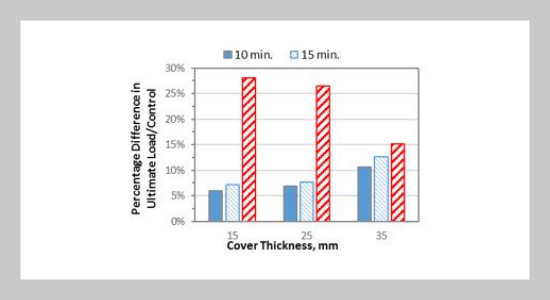REFERENCES
- [1] G. A. Khoury. Compressive strength of concrete at high temperatures: A reassessment. Magazine of Concrete Research, 44(161):291–309, dec 1992.
- [2] Franz-Josef Ulm, Olivier Coussy, and Zdenˇek P. Bažant. The “Chunnel” Fire. I: Chemoplastic Softening in Rapidly Heated Concrete. Journal of Engineering Mechanics, 125(3):272–282, mar 1999.
- [3] YN Chan, X Luo, W Sun Cement Research, Concrete, and Undefined 2000. Compressive strength and pore structure of high-performance concrete after exposure to high temperature up to 800 C. Cement and Concrete Research, 30(2):247–251, 2000.
- [4] Gabriel Alexander Khoury. Effect of fire on concrete and concrete structures. Progress in Structural Engineering and Materials, 2(4):429–447, oct 2000.
- [5] V Vydra, F Vodák, O Kapiˇcková, , Š Hošková Cement Concrete, and Undefined 2001. Effect of temperature on porosity of concrete for nuclear-safety structures. Cement and Concrete Research, 31(7):1023–1026, 2001.
- [6] Al-Owaisy, S.R. and N.N.Al-Chalabi. Non Destructive Tests on Concrete Exposed to Temperatures up to 700o C. Journal of Engineering and Development, 8(1):29–37, 2004.
- [7] JB Odelson, EA Kerr, W Vichit-Vadakan Cement Research, Concrete, and Undefined 2007. Young’s modulus of cement paste at elevated temperatures. Cement and Concrete Research, 37(2):258–263, 2007.
- [8] J Davidovits Journal of Thermal Analysis and Calorimetry and Undefined 1991. Geopolymers: inorganic polymeric new materials. Journal of Thermal Analysis, 37(8):1633–1656, 1991.
- [9] P Duxson, JL Provis, cement, GC Lukey concrete . . . , and Undefined 2007. The role of inorganic polymer technology in the development of ’green concrete’. Cement and Concrete Research, 37(12):1590–1597, 2007.
- [10] JY Chen, S Tao, XR Lei, XY Zhu Applied Mechanics And, and Undefined 2014. The characteristics of metakaolinite-based geopolymer at different temperature. Applied Mechanics and Materials, 442:152–155, 2014.
- [11] T Bakharev Cement Research, Concrete, and Undefined 2006. Thermal behaviour of geopolymers prepared using class F fly ash and elevated temperature curing. Cement and Concrete Research, 36(6):1134–1147, 2006.
- [12] Ping Duan, Chunjie Yan, Wei Zhou, and Wenjun Luo. Thermal Behavior of Portland Cement and Fly Ash–Metakaolin-Based Geopolymer Cement Pastes. Arabian Journal for Science and Engineering, 40(8):2261– 2269, aug 2015.
- [13] P Duxson, GC Lukey, JSJ van Deventer Journal of Non-Crystalline Solids, and Undefined 2006. Thermal evolution of metakaolin geopolymers: Part 1–Physical evolution. Journal of Non-Crystalline Solids, 352(52- 54):5541–5555, 2006.
- [14] En-Hua Yang, Kang-Hai Tan, Mukund Lahoti, Keng Khang Wong, and Kang Hai Tan. Effects of Si/Al molar ratio on strength endurance and volume stability of metakaolin geopolymers subject to elevated temperature Field demonstration of Precast Ultra-thin Whitetopping (PUTW) View project Explore Concept of Membrane Actions to Reduce Fire. Ceramics International, 44(5):5726–5734, 2018.
- [15] AM Rashad, AA Hassan, SR Zeedan Applied Clay Science, and Undefined 2016. An investigation on alkali-activated Egyptian metakaolin pastes blended with quartz powder subjected to elevated temperatures. Construction and Building Materials, 122:417–425, 2016.
- [16] P Behera, V Baheti, J Militky, P Louda Construction Materials, Building, and Undefined 2018. Elevated temperature properties of basalt microfibril filled geopolymer composites. Construction and Building Materials, 163:850–860, 2018.
- [17] R He, N Dai, Z Wang Advances in Civil Engineering, and Undefined 2020. Thermal and Mechanical Properties of Geopolymers Exposed to High Temperature: A Literature Review. Advances in Civil Engineering, 7532703:1–17, 2020.
- [18] Pavel Rovnaník and Kristýna Šafránková. materials Thermal Behaviour of Metakaolin/Fly Ash Geopolymers with Chamotte Aggregate. Materials, 9(7):535, 2016.
- [19] DLY Kong, , JG Sanjayan Cement concrete Research, and Undefined 2010. Effect of elevated temperatures on geopolymer paste, mortar and concrete. Cement and Concrete Research, 40(2):334–339, 2010.
- [20] AZM Ali, J Sanjayan, M Guerrieri Construction Materials, Building, and Undefined 2017. Performance of geopolymer high strength concrete wall panels and cylinders when exposed to a hydrocarbon fire. Construction and Building Materials, 137:195–207, 2017.
- [21] Kang-Hai Tan, En-Hua Yang, Mukund Lahoti, and Kang Hai Tan. A critical review of geopolymer properties for structural fire-resistance applications Design Guideline and Analytical Tool to Mitigate Progressive Collapse of Buildings against Explosive Effects (GPC) View project master thesis View project A critical re. Construction and Building Materials, 221:514–526, 2019.
- [22] J Ren, H Chen, T Sun, H Song, M Wang Advances in Materials, and Undefined 2017. Flexural behaviour of combined FA/GGBFS geopolymer concrete beams after exposure to elevated temperatures. Advances in Materials Science and Engineering, 2017, 2017.
- [23] AM Ibrahem AL-Fatih Journal and Undefined 2008. Effect of temperature on the pozzolanic properties of Metakaolin produced from Iraqi kaolin clay. AL- Fatih Journal, Diyala University, Iraq, 4(32):268–285, 2008.
- [24] Basil S Al-Shathr, Tareq S Al-Attar, and Zaid A Hasan. Optimization of Geopolymer Concrete Based on Local Iraqi Metakaolin. Technical report, 2015.
- [25] J. C. Dotreppe, J. M. Franssen, A. Bruls, R. Baus, P. Vandevelde, R. Minne, D. Van Nieuwenburg, and H. Lambotte. Experimental research on the determination of the main parameters affecting the behaviour of reinforced concrete columns under fire conditions. Magazine of Concrete Research, 48(6):117–127, 1997.
- [26] MM Bikhiet, NF El-Shafey, HM El-Hashimy Alexandria Engineering, and Undefined 2014. Behavior of reinforced concrete short columns exposed to fire. Alexandria Engineering Journal, 53(3):643–653, 2014.
- [27] HY Zhang, GH Qiu, V Kodur, ZS Yuan Cement Composites, Concrete, and Undefined 2020. Spalling behavior of metakaolin-fly ash based geopolymer concrete under elevated temperature exposure. Cement and Concrete Composites, 106, 2020.
















